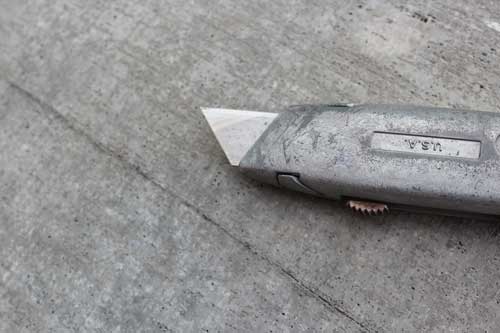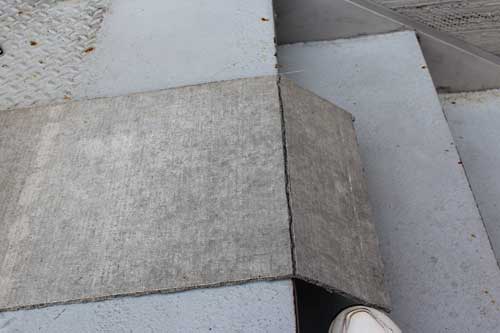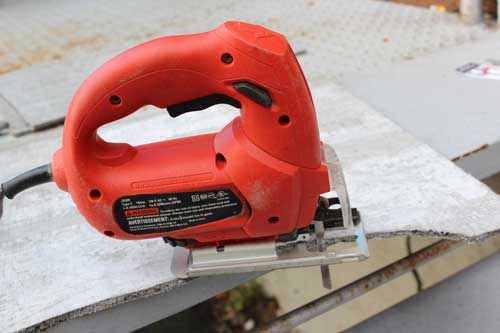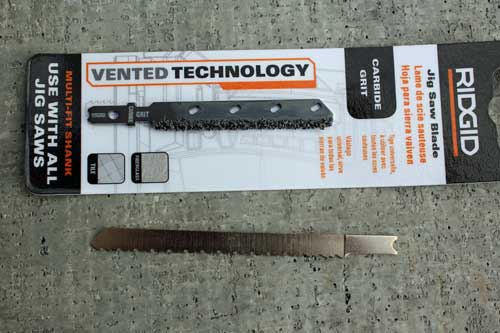Two Types Of Cement Board
There are two types of cement board: The first type contains wood fibers or wood particles mixed in with the cement. The second type is portland cement between two sheets of fiberglass mesh. The second type is completely water resistant, and that is what we use in our mosaics when we use cement board.
Two Methods of Cutting Cement Board
There are two methods for cutting cement board: score-then-snap and jigsaw. The score-then-snap is faster and creates less dust, but it can only be used for straight line cuts.
Score-Then-Snap
The Score-Then-Snap method uses a box cutter to score the board, with the purpose of the score being to cut the strands of fiberglass mesh on that side of the board. A pencil and straight edge (yardstick or carpenter’s square) is used to measure and mark the board before cutting. Cut slowly and firmly to avoid deviating from the line, which happens all too easily due to the surface roughness and the blade snagging on the mesh. Tip: Cement board dulls blades very quickly, so use an old blade and not a fresh sharp one.

Make a second pass in your score to make sure all strands of the fiberglass mesh have been cut. Once that is done, the cement board can be snapped with minimal force using the edge of your work surface. You can also slide a yardstick under the board and line one edge of the yardstick up with the score. Pressing down on both sides should snap the board.

The third step is to flip the board over and cut the fiberglass mesh on the back side using the box cutter.
Jigsaw
Jigsaws can be used to make curved cuts in cement board, but the process does create silica dust, so wear a dust mask.

Run the jigsaw at slow speed to minimize the amount of dust you create. Also make sure the cement board is supported and not allowed to flap up and down during the cut. It is possible to damage the board and weaken it by flexing and cracking the concrete.
Of course, the blade in the jigsaw should be a carbide grit blade, which is different from the toothed blades used to cut wood and metal. However, if you are like me, you save and “downcycle” everything, and you can use old wood blades that have become too dull and worn out to cut wood cleanly. The coarser the teeth the better. Run the jigsaw at slow speed and be prepared to change out blades when the teeth get worn off, which happens quickly.

How To Cut Holes For Sinks
Sometimes you need to cut holes in cement board, which is commonly done for sinks in countertops. You can use a jigsaw for that, but the problem is how to get the blade started. The solution is to drill a hole in the cement board using a masonry bit. Here are a couple of tips for doing this without damaging the board:
Tip 1. Drill Pilot Hole In Wasted Material
Drill the pilot hole in some of the wasted board to be cut out not right on the line of the cut because you are likely to mess up the smoothness of the sink hole if you try to drill your starter hole there.
Tip 2. Support The Board While Drilling
Make sure the board is supported completely underneath when you drill it and not sticking out over the edge of your work surface. The pressure of drilling is enough to flex and bend the board, which cracks the cement.
When To Use Cement Board As A Mosaic Backer
Indoor mosaic plaques and table tops can be made on plywood, but architectural mosaics such as floors and backsplashes and countertops should be made on cement backer board. The reason is simple: plywood can compress, sag and flex over time, especially when the plywood is part of a house with all that implies about exposure to humidity, water and structural stresses over time.
Most of the building material stores I have used (mostly Home Depot in Georgia) carry the fiberglass mesh variety of cement backer board in two thicknesses: 1/4 inch and 1/2 inch. They say you can use 1/4 inch in flooring because the concrete backer board doesn’t supply any structural strength to the floor, but I’ve noticed that the edges of 1/4 inch board tends to get damaged more easily during handling and construction, especially if the tile doesn’t get laid right away. That being said, you might need to use 1/4 inch on your floor merely to save weight.
An Important Note About Weight
When installing tile floors, make sure you have a carpenter look at the joists under the floor to make sure it can hold the weight of the backer and the mosaic tile.

Leave a Reply